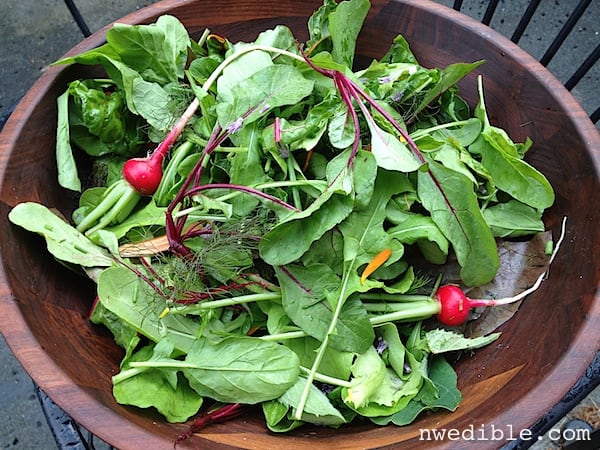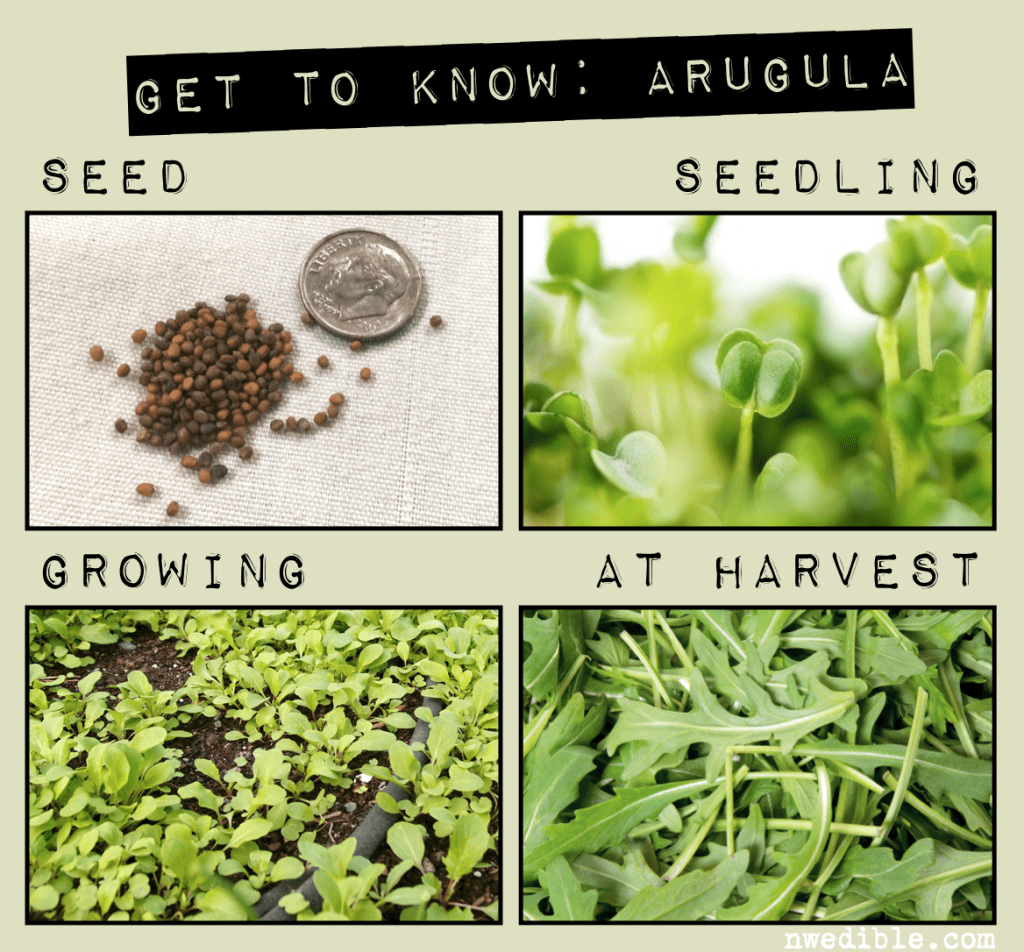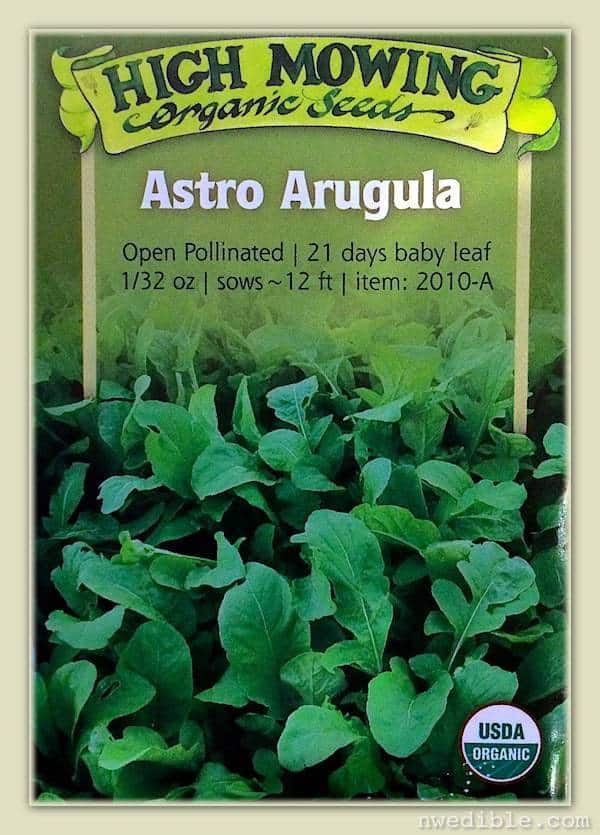It is inconceivable to me that arugula of all plants got pinned as a vegetable of elitism in American politics. Are you kidding me? Belgium endive, sure. Forcing chicons in the middle of winter just screams “I have people to do that for me.” Even cauliflower I could see; that’s one finicky veg.
But arugula? The stuff is one breeding line away from being an invasive weed. It germinates fast, grows fast, and self-seeds readily. Pests rarely bother it. It’ll grow in garden beds or garden paths or under other vegetables. It’s an easy vegetable. And it tastes great on pizza, too. Yeah, don’t let the political hype fool you – if there was ever a vegetable for the everyman, it’s arugula.
What Arugula Tastes Like and How To Eat It

Arugula is a peppery, tender green best eaten at the baby to “teenage” leaf stage. In hot weather or when overly mature it gets unpleasantly spicy and can taste a bit metallic or bitter.
Arugula is excellent in spring, fall and winter salads, can also be added to soups and made into pesto. My favorite way to eat arugula is something we call “salad pizza.” This is a thin crust pizza made with your favorite cheese, meat, veg – whatever – and topped with a big heap of salad greens when the pizza comes out of the oven. Prosciutto and fresh fig pizza topped with a bunch of arugula is my favorite.
What Arugula Looks Like From Seed to Harvest
Like all brassicas, arugula seeds are small spheres, medium brown to black in color. The cotyledons (seed leaves) have a squatty, heart shape. Baby and mature leaves can be strappy, similar to baby romaine, or toothed and cut-leaf, similar to oak leaf lettuce.

Arugula Basics
- Common Name: Arugula
- Latin Name: Eruca sativa
- Family: Cabbage (Brassicaceae)
- Hardiness Zones: All, though arugula can be disappointing in hot climates.
- Lifecycle: Annual.
- Season: Cool. Does best in early spring and fall. Increasing day length and hot weather cause arugula to bolt quickly.
- Days to Maturity: About 20 days for the first baby leaves, 30-40 for a harvest of larger leaves.
- How Hard Is It To Grow? Very easy in cool weather.
Pacific Northwest Specific Tips and Timing
Arugula is falling-off-a-log-easy in the Pacific Northwest. Our long, cool springs and mild winters mean a good harvest of arugula is possible more months than not here.
Spring Sowing: Succession sow small patches from early March through end of May. Start 2-4 weeks earlier under a low tunnel or cloche if desired. Succession harvest late March – June.
Fall Sowing: Succession sow small patches from late August through mid-October. You can continue sowing into mid-November if you employ season extension techniques, or for an overwintering crop. Succession harvest from late September on. In a mild winter, arugula will survive without protection, but low tunnels or cloches will help the plant grow more, and may keep it in better condition through winter.
How To Plant Arugula
Seeds or Starts? Seeds, always. I broadcast sow out in wide swaths as a cut-and-come-again crop. Do not start indoors – arugula germinates well in cooler soil and arugula transplants almost always bolt immediately. Why make work if you don’t have to?
Sowing: Plant seeds shallowly, about 1/4-inch deep. I just scatter seeds over the soil surface and rake or water them in. Broadcast lightly – about one seed per square inch is good for cut-and-come-again crops, or space 4-6 inches apart in all directions to harvest larger, more mature leaves.
Growing Indoors: The is a great crop to grow indoors for sprouts and microgreens. No special equipment is needed -because arugula is typically eaten young, you can even grow a container for microgreens in your best, south-facing window.
Arugula Seed Info
Typical Seed Life: 3 years.
Recommended Cultivars: Astro is a classic cultivated arugula with a peppery flavor, Sylvetta or Roquette is essentially wild arugula – stronger and hotter in flavor, and more cold tolerant.
Germination: Arugula tends to germinate very rapidly, in a week or less. Soil from 40* F to 50*F is excellent for germination. Warmer soils may encourage extremely fast (48 hours) germination, but will lead to faster bolting.
How Much To Plant: There are about 18,100 arugula seeds per ounce (or 28 grams). Arugula has an average germination of 75%. So, at a one-seed-per-square-inch spacing, 200 seeds will very generously sow one square foot of garden with arugula as a cut-and-come-again crop. One ounce of arugula will sow about 90 square feet, and one gram will sow a bit over 3 square feet as a thick mat of cut-and-come-again greens that will regrow several times for multiple cuttings.
At a “mature plant” spacing of 4 to 6 inches, 15-20 seeds will generously sow one square foot. At this spacing, one ounce will sow 900 square feet and one gram will sow about 32 square feet.
A typical family will probably find that sowing one square foot (or less) every 4 weeks or so through the cool seasons will keep them in all the arugula they can eat. Arugula is notorious for self-sowing, and the best way to ensure an inexhaustible supply of the stuff is to let a few plants go to seed. You’ll never be without it again.
Arugula’s Growing Needs
Sunlight: Full sun to part sun, 6+ hours of sun per day is best but with cooler temps. In the Pacific Northwest, arugula doesn’t need heat protection, but in hotter climates, protection from afternoon sun will help to delay bolting.
Soil Conditions: Evenly moist during germination – arugula sprouts are little things and can dry out quickly. Average garden soil with a pH of 6.5 to 7 is fine – arugula isn’t too picky.
Feeding: In well managed garden soil, background fertility should be sufficient. If young leaves show signs of yellowing and are not water-stressed, side dress or foliar feed with a high-nitrogen organic fertilizer like blood meal.
Watering: For best quality arugula, keep soil around young plants evenly, lightly moist – water stress can cause premature bolting and a stronger flavor. However, arugula is good at finding water and, if allowed to mature, can send down impressive tap roots that will help break up heavy soil.
How To Harvest Arugula
“Mow” swaths of baby arugula with scissors, holding clumps of leaves lightly upright in one hand and cutting about an inch above the soil line with the other. Cut when the leaves are 3-4 inches tall. Leave the plants in the ground, they will regrow for another harvest.
Alternatively, on larger spacings, allow individual plants to grow 6-7 inches tall, and pick the outer leaves from the arugula rosette. Leave the inner leaves to continue to grow.
Arugula’s Friends and Foes

Arugula under sown with growing cabbage – get twice the harvest from your garden space!
Pests: Flea beetles will chew the leaves. Grow under lightweight row cover to avoid damage. Otherwise, few pests.
Diseases: Arugula is typically unbothered by disease.
Companions: Arugula intercrops and undercrops beautifully with slow growing, large plants like eggplant, tomatoes, summer squash or cabbage. By the time these crops need their full space, the arugula will be long harvested. It can also be grown in a block, adjacent to lettuce or spinach to make a living quilt of salad greens.
Antagonists: Avoid planting with low-growing creeping plants like strawberries which will tend to smother arugula seedlings.
Do you grow arugula? It’s one of my favorites!
34

Hi
I’d love to try growing this in Australia. I haven’t heard of this ever before. Another unusual vegetable, over here anyway, is spaghetti squash. It’s so yummy! I wrote and article about it here: http://www.weekendnotes.com/spring-creek-organic-farm-shop/ It can be used as pasta for people who are on a paleo food plan, or for gluten or grain intolerant people. Or for people who prefer veggies!
Thanks for the great info.
Cheers
Miche
Miche, it’s called rocket in Australia.
Haha, this “vegetable of elitism” has gone native in my backyard. I find it popping up here and there in the grass all the time.
I’ve grown arugula for years along with garden cress here in the wilds of the Idaho Panhandle. I had no idea I was being elitist. Though now that I come to think of it, I have also grown Belgian endive for forcing and cauliflower. Yikes! Who knew?! Thanks for the tip about arugula on pizza. I’ll have to give that a try when I’m up to my ankles this spring. Great post!
I sowed some arugula two springs ago and had a couple of plants, one of which I let go to seed to try and save. I did save some, but it spread the rest out everywhere. My first arugula (Portland, OR) sprouted in my front lawn in early January with no protection or anything! Definitely a must have if you like greens and/or have chickens (who eat all the arugula I can’t). The flowers are sort of pretty, too, white and star shaped, so if you can tolerate weedy looking plants for a couple of months your first sowing of arugula could be your last 🙂
PS: Erica, your new photo (new-ish, I noticed it a while back?) looks fantastic!
If you are in a mild part of the Pacific northwest and had surface sown arugula about three weeks ago at the beginning of the January heat-wave, you would have seedlings nearly an inch tall by now. It is definitely one of the best greens for continuous sowing in the winter garden, along with mache and chicories. Frost makes it sweeter and so does the sense of superiority!
“So does the sense of superiority” ROFL. Awesome.
Now how about some tips on growing amaranth – it is very healthy I hear and will not take to being genetically engineering to something else.
It’s likely already growing in your yard or nearby. There are tons of wild varieties of amaranth that grow like crazy. Learn what the wild varieties in your area look like, and start munching. Alternatively, the varieties grown for leaves will also self-seed like crazy toward the middle/end of the summer. Just keep cutting so they don’t get out of control and you will have 100,000 more next year!
I’ve been enjoying Territorial Seed’s WILD ARUGULA from seed for some years now—from the same patch! Periodically I dig a hunk, cut it back and tuck it in an empty little garden spot. THis yields lovely big leaves. The original (i.e. crowded) patch has mostly smaller leaves but just keeps on giving. I’ve given away many clumps, too. REALLY recommend it.
We grew the high mowing astro arugula last year and LOVED it! I still can’t believe that last year was the first year I grew arugula, and it was my 5th year gardening! Not sure what took me so long to try it, but I ain’t going back!
Elitest Arugula? Wait…I think I hear generations of thrifty Italian cooks snorting in their Chianti.
Sarcasm aside, Flea Beetles are the only thing I ever have a problem with, and I suppose it’s a perspective thing…the hens love their arugula with a little extra protein.
That’s a great level of detail, thank you so much! Arugula probably wouldn’t have made it onto my seed list this year, but I think you tipped me over the edge. 😀
Love the suggestion to grow it under large brassicas. Another great post. Can hardly keep up with you this month!
I recently moved to Oregon from Arizona. It was always a surprise to find arugula volunteers growing in gravel after the summer monsoons, down there. Arugula is much ‘stronger’ flavored in that hot climate, than up here. I am happily gardening away, in the Pacific NW & glad to be here!
Great post. Thanks. I’m recently settled in Victoria and have been having arugula challenges, when growing from seed! Fast bolting to seed. Spindly plants. Bought seedlings are doing better. They’re planted in good soil and getting 6+ hrs sun a day. It’s a mystery. I have grown this fabulous green for years in warmer climes. Any hints?
Best guess? Arugula like mustard greens, tend to bolt VERY rapidly when planted during a time of rapidly increasing daylight. As we approach the summer solstice, everything about the day length triggers are telling arugula to make seed. Try again from seed several weeks after the solstice (try mid-August) and you should have better luck. If you don’t, then you have seed that is very poorly grown and I recommend getting better seed. If seed growers don’t rogue out fast-bolters from the seed stock, that propensity gets passed down and tends to get worse and worse over the seed-generations.
Is it sensible and healthful to dry arugula leaves and use them for tea?